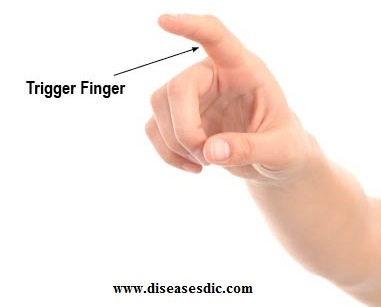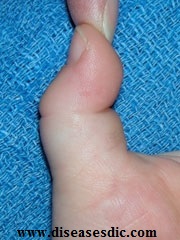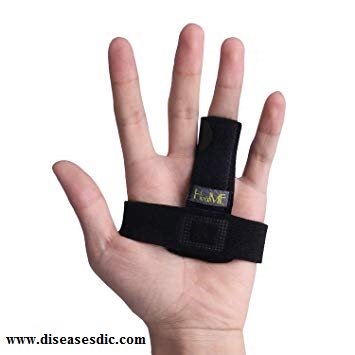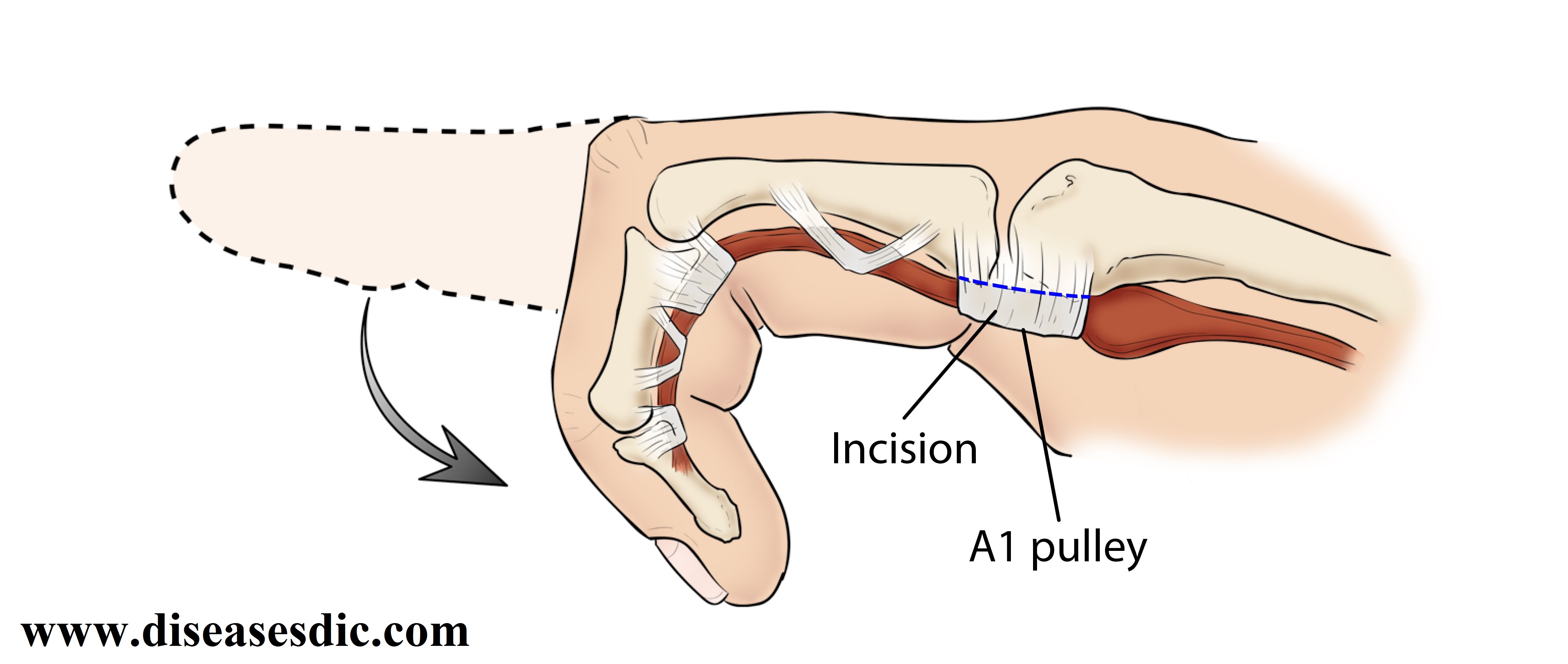Definition
Trigger finger or stenosing tenosynovitis is a condition that involves one of the fingers or thumbs becoming stuck in a bent position and then rapidly straightened like the trigger of a gun. This condition is caused by a narrowing of the sheath that surrounds the tendons in the finger, and is common in people who perform repetitive gripping actions but can occur in anyone. Trigger finger causes stiffness, pain and may eventually lead to an inability to completely straighten the finger. When you try to straighten your finger, it will lock or catch before popping out straight.

Epidemiology
It is one of the most common causes of hand pain in adults. The reported prevalence is roughly 2 percent in the general population, and is more common among women than men in the fifth or sixth decade of life. It can occur in one or many fingers in each hand and can be bilateral. The prevalence of trigger finger is also higher among patients with diabetes mellitus, rheumatoid arthritis, or conditions that cause systemic deposition of protein such as amyloidosis. Trigger finger is occasionally observed in children.
Trigger Finger risk factors
Risk factors may be more likely to develop trigger finger if you have any of the following conditions:
Diabetes: A long-term condition that is caused by too much glucose in the blood
Rheumatoid arthritis: A long-term condition caused by a problem with your immune system (the body’s defence system), resulting in pain and stiffness in your joints
Gout: A short-term condition that causes inflammation (swelling) in one or more of your joints
Amyloidosis: A condition where abnormal protein called amyloid builds up in organs, such as your liver
Underactive thyroid: Your body does not produce enough of certain hormones
Mucopolysaccharide storage disorders: A group of rare disorders that cause progressive physical and sometimes mental disability
Carpal tunnel syndrome: Acondition that affects the nerves in your wrist, causing pain and tingling
Dupuytren’s contracture: A condition that causes one or more fingers to bend into the palm of your hand
De Quervain’s disease: A condition that affects the tendons in your thumb, causing pain in your wrist
Causes of Trigger Finger
Trigger finger is caused by inflammation of the tenosynovium. The tenosynovium is the substance that lines the protective sheath around the tendon in the finger. This substance enables the tendon toglide smoothly within the sheath when the finger is bent or straightened.
When inflammation is present, the tendon is unable to glide smoothly within its sheath causing “catching” of the finger in a bent position and then suddenly releasing the finger straight. Causes of trigger finger can include the following:
Repetitive Motion: Individuals who perform heavy, repetitive hand and wrist movements with prolonged gripping at work or play are believed to be at high risk for developing trigger finger.
Medical Conditions: Conditions associated with developing trigger finger include hypothyroidism, rheumatoid arthritis, diabetes, and certain infections such as TB.
Gender: Trigger finger is more common in females than males.
Symptoms
The most common symptom of trigger finger is stiffness in the joints of the finger, especially in the morning. Other symptoms may include:
- Popping or clicking is felt when moving the finger
- Tenderness, sometimes accompanied by a lump in the palm of the hand at the base of the affected finger
- Swelling
- Finger is locked in a bent position and is unable to straighten

Trigger thumb, stuck in a flexed position
Symptoms are usually worse in the morning and after periods of inactivity. Maintaining mobility and activity in the fingers will keep them from becoming too stiff. In some cases, more than one finger may be affected.
In children with the congenital form of the condition, there is often no pain related with the bent finger position and there is generally no history of trauma or continuing use of the joint. In about one fourth of all congenital cases, the condition befalls in both hands.
Diagnosis
Your doctor will start with a physical exam of your hand and fingers. The finger may be swollen, stiff, and painful. You might have a bump over the joint in the palm of your hand. Or it could be locked in a bent position. There are no X-rays or lab tests to diagnose trigger finger.
Treatment of Trigger Finger
Nonsurgical Treatment
Initial treatment for a trigger finger is usually nonsurgical.
Rest: Resting your hand and avoiding activities that make it worse may be enough to resolve the problem.
Splinting: Wearing a splint at night to keep the affected finger or thumb in a straight position while you sleep may be helpful.

Trigger Finger Splint
Exercises: Gentle stretching exercises can help decrease stiffness and improve range of motion in the involved digit.
Medications: Over-the-counter medications, such as acetaminophen and nonsteroidal anti-inflammatory drugs (NSAIDs), can help relieve pain and inflammation.
Steroid injections: Corticosteroid, or cortisone, is an anti-inflammatory agent that can be injected into the tendon sheath at the base of the trigger finger. A steroid injection may resolve the triggering over a period of one day to several weeks. If symptoms do not improve with time, a second injection may be given. If two injections do not help the problem, surgery may be considered.
Steroid injections are less likely to be effective in patients with diabetes, but may still help avoid surgery. They can cause a short-term rise in blood sugar, so glucose levels in diabetic patients should be monitored after injection.
Surgical Treatment
If your finger does not get better with nonsurgical treatment, you may wish to consider surgery. Surgery is elective. The decision for surgery is based on how much pain or loss of function you have in your finger. If, however, your finger or thumb is stuck in a flexed or bent position, your doctor may recommend surgery to prevent permanent stiffness.
Surgical procedure: The surgical procedure for trigger finger is called “tenolysis” or “trigger finger release.” The goal of the procedure is to release the A1 pulley that is blocking tendon movement so the flexor tendon can glide more easily through the tendon sheath.

During trigger release surgery, the A1 pulley is cut (dotted blue line)
Complications
Complications are rare with trigger finger release surgery. However, as with any surgery, complications could occur and include:
- Infection
- Pain or stiffness in your finger
- A tender scar
- Nerve damage
- Bowstringing – where the tendon is in the wrong position
- Complex regional pain syndrome (CRPS) – pain and swelling in your hand that usually resolves after a few months.
Prevention of Trigger Finger
- Avoiding overuse is the main component of preventing trigger finger.
- If you have diabetes, rheumatoid arthritis, or any reason to believe you are more prone to getting trigger finger consider practicing the exercises from above.
- If you feel a slight onset of trigger finger resting your hand will be the most effective way to avoid further issues.
 Diseases Treatments Dictionary This is complete solution to read all diseases treatments Which covers Prevention, Causes, Symptoms, Medical Terms, Drugs, Prescription, Natural Remedies with cures and Treatments. Most of the common diseases were listed in names, split with categories.
Diseases Treatments Dictionary This is complete solution to read all diseases treatments Which covers Prevention, Causes, Symptoms, Medical Terms, Drugs, Prescription, Natural Remedies with cures and Treatments. Most of the common diseases were listed in names, split with categories.








I’m a diabetic and I be been suffering from this trigger of fingers and even legs.
Even my legs swell up sometime .please help me. I have been with diebetis for almost 21 years
please consult a doctor for the appropriate prescriptions.
what’s treatment by medicine in that.
corticosteroid or cortisone.
The hand of the most part of your health care system and the rest is that it was great what Save
hello doctor.. am facing auto immune disorder having rheumatoid arthritis and scleroderma also.. please suggest the best
Please consult a doctor.
Your treatment on trigger finger has solved my problem .Continue good work !
I have trigger finger of my left n right thumbs, I have seen my Dr, surgery done n injection given with no effect, suffering from hypothyroidism pls what next? Thanks.
Please follow the advice of the doctor.
hello dr. im suffering in this desease that my right hand thumb has gone completely straight but sometime it bent nd i straight it other hand n so much pain. no swalloing found but pain is continues. plz suggest some exercise r medicine r adivice.
Please consult an orthopedic doctor asap.
hi doctor, I have a similar condition bt mine affects my toes. it bents in any direction and becomes so painful to straighten it. it affects all the toes though it isn’t persistent. could it be the same? thanks
please consult a doctor.